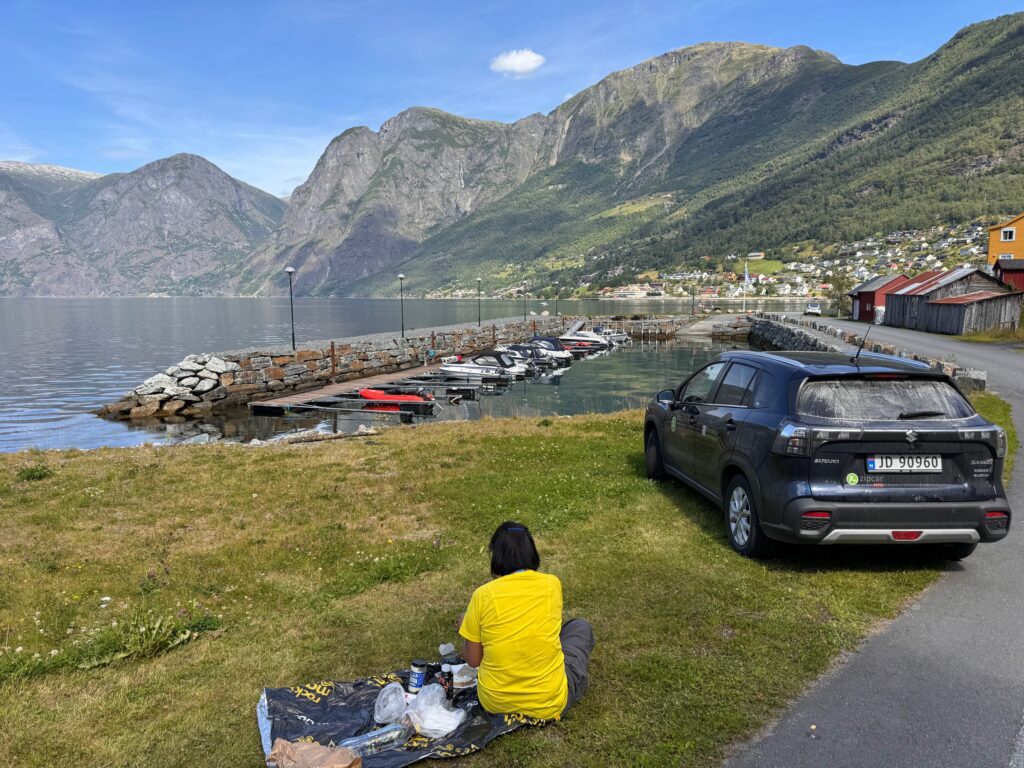Enjoying lunch on the side of the road near Aurland
Highlights
How to travel Norway on a limited budget. The cheapest way of efficiently seeing Norway on a budget is car camping.
Time of Visit: July – August 2024
Duration of Visit: 42 days
Description
Norway is notoriously expensive. Hotels, groceries, restaurants, gas and rental cars are up there in price. Expenses can quickly add up. But there are ways to keep expenses low to see Norway, even for an extended period of time.
But traveling on a budget comes with tradeoffs. The less you spend, the less comfort you may have. So it just boils down to your budget and what you can endure while traveling.
In this article, we will cover three different ways of traveling around Norway. These are car camping, campervan and renting a car while staying at rental apartments. We will also discuss your options on going to the bathroom if you decide on car camping or renting a campervan. We will also cover how you can score the cheapest rental car possible.
Car Camping


Car camping is probably the cheapest way to travel and have efficient use of your time. But it is not for everybody. It is the least comfortable of the three ways to travel described here. However, the allure of having such an adventure is just irresistible.
Norway has the term “allemannsretten” which means “everyman’s right”. This is a law that allows everyone to roam free on uncultivated land.
What this means is that anyone, whether locals or visitors, can camp almost anywhere as long as there is no posted sign that states otherwise. We saw campervans and recreational vehicles take over public parking lots to spend a night or two. We even saw cars with erected rooftop tents on the side of the road.
With car camping, your accommodation is your car. Pick a spot, verify there are no “No Camping” signs and enjoy the view before settling in for the night.
Tent or Sleep Inside The Vehicle?
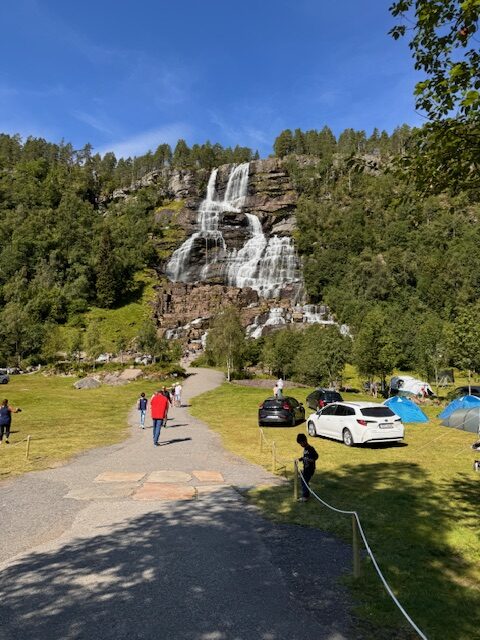

You can do both. Sleeping inside a vehicle is the simplest. All you have to do is make the bed and you are ready to have some shut-eye. The only issue is making sure that you can lay flat inside the vehicle to have a comfortable sleep.
However, there is no guarantee that what you reserved is what you are going to get at the car rental counter. It just depends on supply and demand. If there were a few people that were ahead of you and reserved the same class of vehicle, chances are you will not get what you reserved.
So what do you do to mitigate this uncertainty? You basically have two options. It is either you bring a tent and sleeping pad or rent a campervan.
Campervan
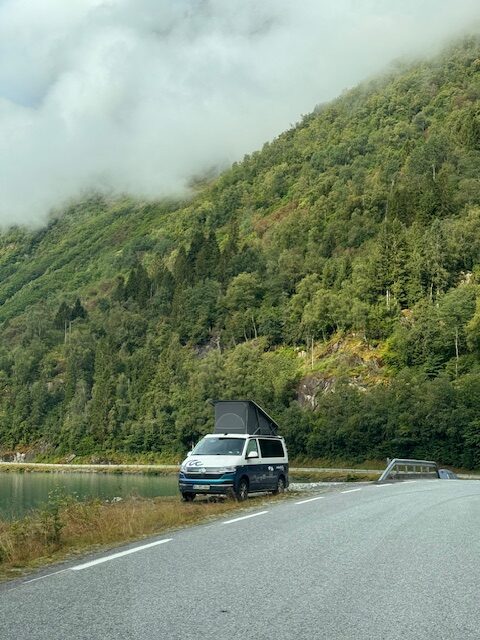

A campervan is a great way to see Norway. You will see a lot of people driving campervans and recreational vehicles in Norway. Most of them are privately owned. There are a few companies in Norway that rent out campervans. We looked at Benzini campers but found they were not as economical as we thought compared to staying in rental apartments advertised in Booking.com and AirBnB.
Campervan rentals basically come in two sizes, small and medium sizes. The small version is the size of a Transit Connect which is just big enough for two people to lay flat comfortably. The medium size campervan is similar to a low headroom cargo van. It squeezes in a small kitchen area besides the bed.
Drawbacks
Campervans would have the same drawbacks as car camping. You would still need to find a bathroom to take care of your hygienic needs. Fortunately, Norway has road rest areas that have toilets. Road signs that have the letters “WC” means it has at least one toilet. But sometimes those toilets are locked so there is no guarantee.
Cafes and restaurants would be another option to take care of doing a number one or number two, though it would set you back a few kroners as bathrooms are usually just for customers. For taking a shower, you can either shower outdoors if you have a bucket and water source nearby. Otherwise, staying at private campgrounds or a hostel would be your cheaper option to get cleaned up.
A second drawback is the weather. It is not enjoyable to be stuck inside a vehicle when venturing outdoors means getting wet. We experienced wet weather about one third of the time during our summer road trip in Norway.
The third drawback is economics. This requires careful analysis. Unless you really want to stay outdoors, the cost of renting a campervan may not be any cheaper than staying at privately rented apartments advertised through Booking.com and AirBnB (more later on our average nightly apartment rental cost).
The fourth drawback of going the campervan route is that most rental companies require a deposit at the time of booking. This means you have no flexibility should your plans change.
The last drawback is credit cards do not provide collision damage waiver (CDW) benefits for campervans and recreational vehicles. This means you either take the chance that nothing bad will happen to the rental vehicle during your trip or you buy additional insurance to have peace of mind.
Staying In Rental Accommodations
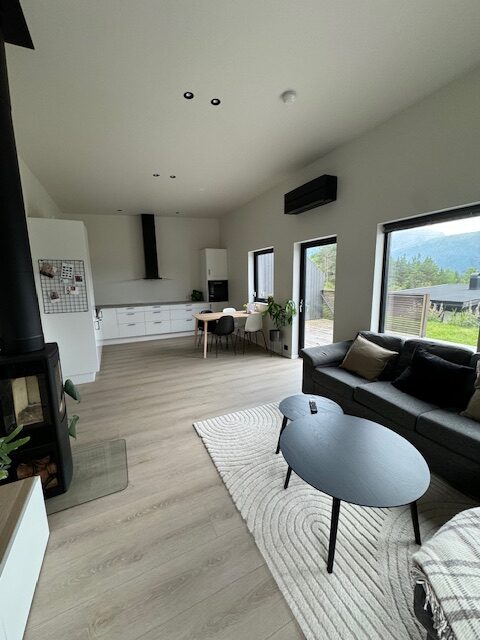

Staying in rental accommodations, whether hotels or apartments, is the most comfortable way to see Norway. You have room to spread out, often a couch to sit on and definitely be able to cook your own meals. If you are lucky, the rental accommodation may even have a washing machine so you can conveniently do your laundry. Almost all have Wifi so you can stay connected.
All you have to do is book a regular car and make accommodation reservations in advance. You can certainly reserve as you go to stay flexible but more than likely, your choices would be limited and the price may not be appealing. Worse, you may not be able to find one in an area where you need to spend the night.
You should strongly consider staying in rental accommodations if you do not mind doing a little research to carefully plan out an itinerary. It is just a matter of booking accommodations once you have an itinerary.
Our Average Rental Accommodation Cost
We were surprised to see that our average nightly rental cost was around $132 USD for the 42 nights we were in Norway. This included 25 days exploring the Western fjords between Lysebotn and Trondheim, two days in Lillestrom which is less than a 30 minute train ride from Oslo and 15 days in the Lofoten Islands including Tromso.
Drawbacks of Rental Accommodations
Two words – limited flexibility. Rental accommodations through AirBnB and Booking.com charge the rental cost as early as a couple months to a couple of days prior to the stay. This means the accommodation would be paid before arrival. If the accommodation or the area turned out to be less appealing, you may be forced to endure it for the rental duration unless you are willing to forfeit the payment. On the other hand, if the area is nice, there is no guarantee that your stay could be extended.
Other Ways to Save
Flying Into Norway
You can directly fly into Oslo or another Norway city that has an international airport or you can make a couple of days stopover in a European city then fly to Norway from there. The former normally costs more for direct flights to Norway from non European countries.
The latter would entail flying into a European city that has cheap flights, spend a couple of nights before continuing to Norway. This only works if you have the time in your itinerary to make a stopover and makes economic sense. Obviously, you would have to choose an initial destination that is to your liking before moving on to Norway.
Lower Rental Car Cost


For ordinary rental cars, it makes sense to start looking early. We booked a cancellable, no deposit required rental car through one of the international rental car chains about four months from our trip. The cost averaged about $80 USD/day.
Once every couple of weeks, we would check car rental booking websites if the price has gone down. If it has, I would make another cancellable no deposit required booking and cancel the other. We continue to do this until a week to a couple of days from the trip. Our final booking would either be directly with the rental car company or through a third party that requires pre-payment or a deposit.
With this method, we were actually surprised to get our car rental cost in Oslo cut in half. I found out from one traveler that he was able to secure a rental cost of $30 USD/day from the same rental car company the day of his trip. I suppose that the rental car demand during our visit was low which resulted in the price drop.
Rental car prices usually go up as you get closer to the travel date. Sometimes rental car companies sell out. So it is better to have a reservation in your pocket while still shopping for a better deal as you get closer.
Campervans on the other hand tend to have a steady rental cost. This is due to the limited vehicle supply as there are only a handful of rental companies that offer such vehicles. So if you are dead set on seeing Norway in a campervan, might as well book it early so you do not run the risk of not being able to rent one when all have been rented out.
Important Things To Know
Tolls On Bridges, Ferries, Roads And Tunnels
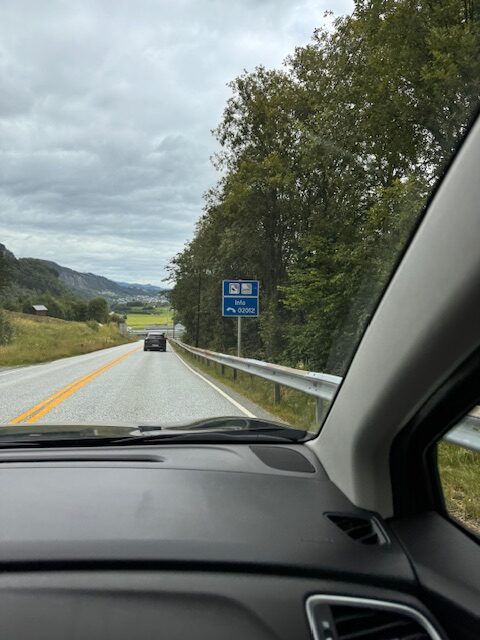

You will undoubtedly be paying a toll to drive on bridges, on roads, through tunnels and on board ferries. It is just unavoidable. Even if you set Google Maps to avoid tolls, you will still encounter one.
Our rental vehicle had a transponder that allowed the bridge, road and tunnel tolls to be billed directly to the rental. We only encountered one bridge that charged a toll. This was the Hardanger Bridge east of Eidfjord.
Most tunnels are free but those that go undersea involve a toll. Ferry employees take photos of car license plates so we assume they charge a fee too.
Our total toll bill appeared as one number that was added on the car rental cost. Car rental companies allow about three working days for all the toll charges before sending out the final invoice. So you would not be able to settle the rental cost when you return the rental vehicle.
If you are leasing or driving your own vehicle, there are a couple of ways you can pay the toll without much headache. One is to order the transponder which arrives by mail. This means you set aside time so that the transponder arrives ahead of your planned trip. The second is to register your vehicle on EZPASS24.
Cameras Everywhere
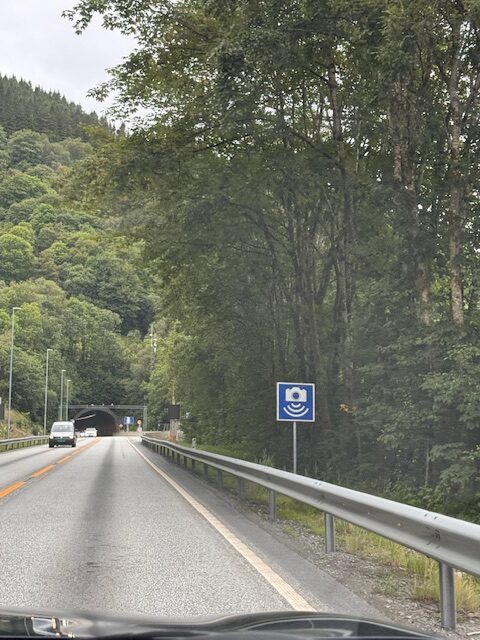

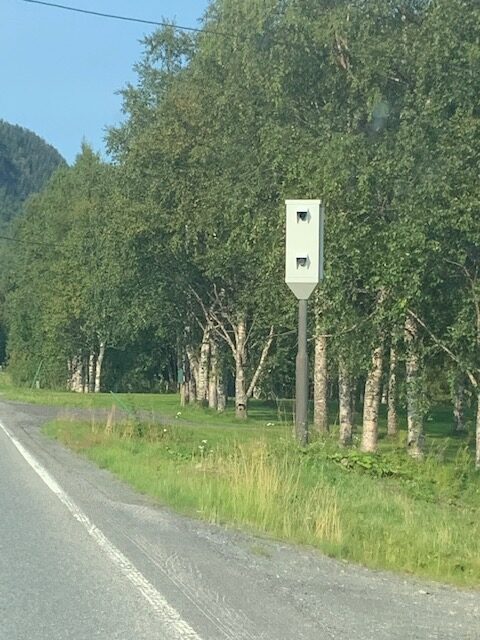

Norway has a lot of road cameras. There may be signs on the road that you are approaching a speed camera which is great. But most of the time, there are no signs so you are not sure if the camera is just for traffic monitoring or for speeding. Best to abide by the speed limit at all times to avoid any hassles.
Speed Limits
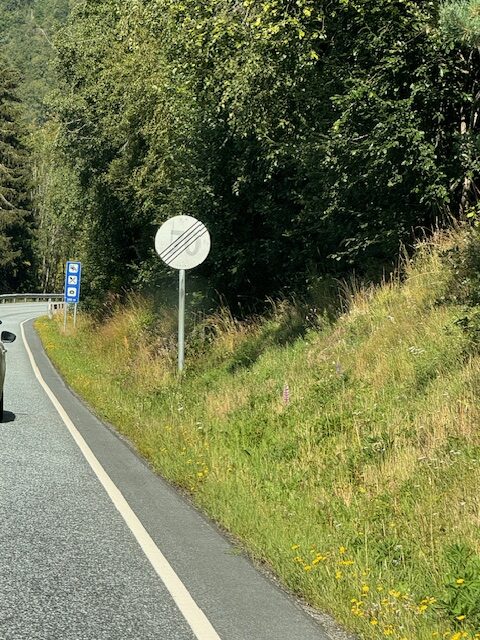

Speed limits in Norway’s rural areas are on the low side. Expect 30 kph while driving within town. The speed limit may go up to 50 kph if the highway cuts through the middle of town. The speed limit gets up to 70 kph once outside of town. Most of the time, there is no posted speed limit which means the limit is 80 kph.
You need to have a lot of patience to drive in Norway. It just takes a while to get from one point to another as there is no interstate like highways outside of Oslo and Trondheim.
Summary
Traveling through Norway on a budget can be challenging, as the country is known for its high cost of living. It requires careful planning and a willingness to embrace a more minimalist, nature-focused travel style. By prioritizing free or low-cost activities, cooking your own meals, and searching for the cheapest transportation and accommodation options, you can explore this beautiful country without spending a fortune.
This guide covered various aspects of budget travel in Norway, including transportation, accommodation, food, activities, and money-saving tips.
Norway’s stunning landscapes, rich cultural heritage, and welcoming atmosphere make it a rewarding destination, even for budget-conscious travelers.

